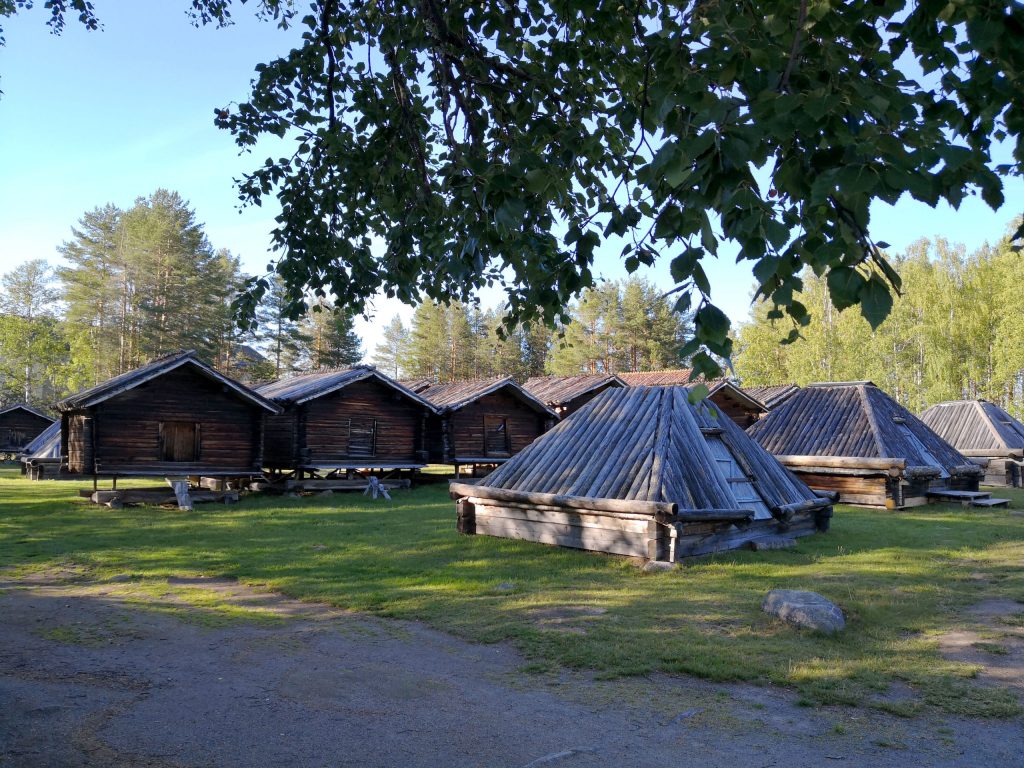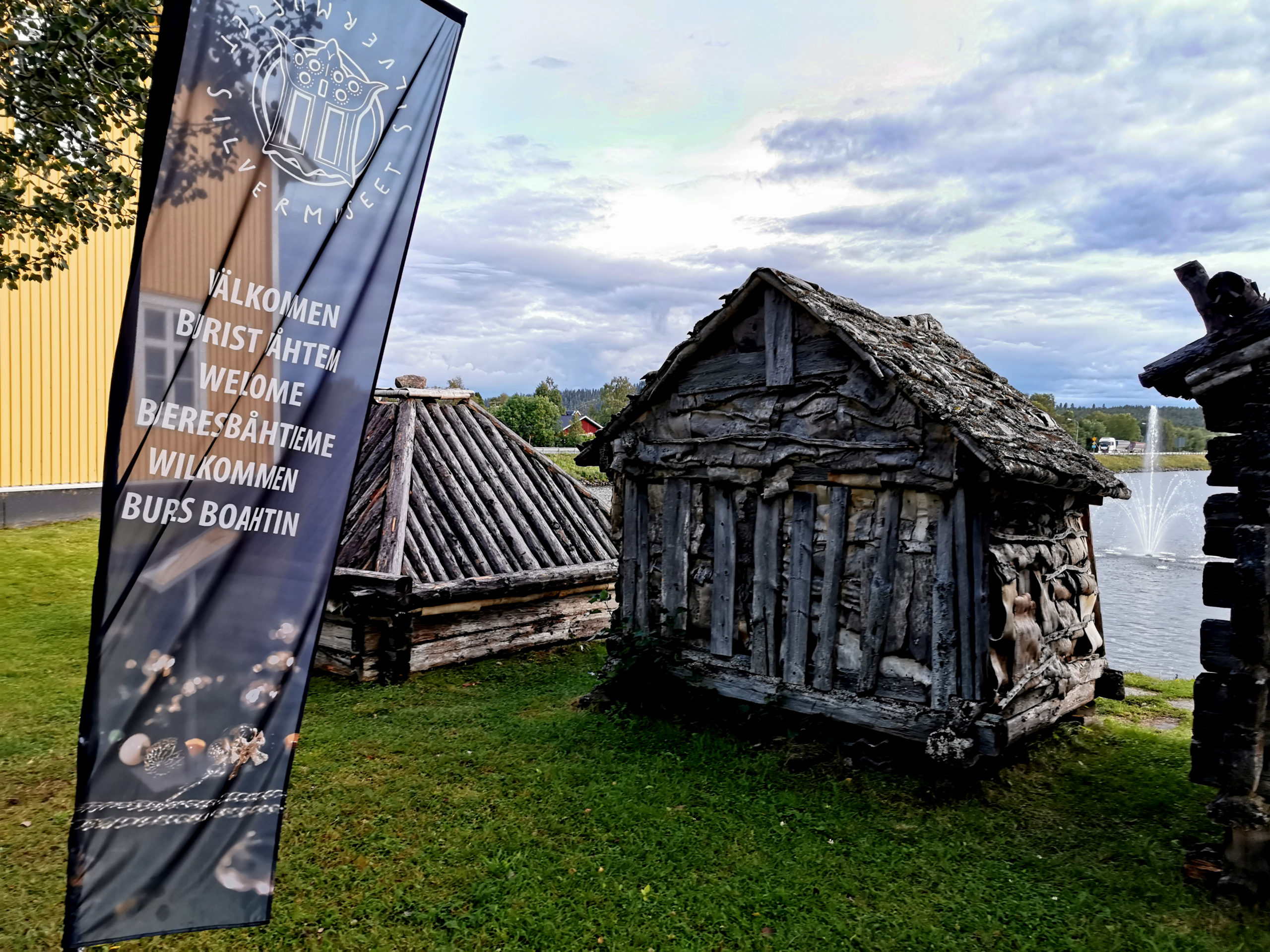The Silver Road is a 500-kilometre highway.
It runs from coast to coast through highly varied terrain.
Trade routes ran here as long ago as the tenth century,
perhaps – or probably – much earlier.

The author Stina Jackson with the novel The Silver Road and the longed-for tunnel in Saltdal on the Norwegian side, the Kjernfjellet Tunnel, was opened in November 2019. Photo Maria Söderberg
In recent years there has been a growing interest in the middle section of the route, which is the Silver Road proper. The number of visitors is rising. Now this major European road, the E95 between Norway and Sweden, has at least three important new features.
1. A big new shop has opened in Jäckvik, a village with 32 permanent inhabitants.
2. The author Stina Jackson has written the bestselling novel The Silver Road, which has sold more than 320,000 copies and has been published in 26 countries.
3. The longed-for tunnel in Saltdal on the Norwegian side, the Kjernfjellet Tunnel, was opened in November 2019.
What is the Silver Road?
I. Ag – Argentum
It was silver ore (Ag from Latin argentum) that gave its name to the road between Skellefteå and Bodø. Five hundred kilometres of asphalt run from coast to coast. On one side the Gulf of Bothnia, on the other the Atlantic. Some of Sweden’s biggest lakes and the mighty river Skellefteälven are located close to the highway. The Arctic Circle crosses the Silver Road where the mountain ridges rise to their highest point, almost 1,900 metres above sea level. Many languages and dialects are spoken in this area where the Sami dominated the inland until the nineteenth century. On the Norwegian side there are breathtaking mountains and long, narrow fjords of great depth. The ice-free harbours of Rognan, Fauske and Bodø guaranteed trade and especially fishing. The church site of Lappstaden was established in Arvidsjaur when the church was built in 1607. According to one interpretation, Arjeplog, a Swedish form of the Pite Sami name Árjapluovve, situated between the big lakes, was a place where people came to trade and pay their taxes. In Skellefteå, a town that originated in the fourteenth century, there was farming, a trading site, a stone church and a harbour from early on. But in Boliden and Skellefteå, along with nearby places, people prefer to rely on another metal: gold. This goes back to a find from 1924 which triggered a gold rush thirty kilometres north-west of Skellefteå at Fågelmyran. This was the foundation for what today is the Boliden Group, with extensive mining operations. The Kingdom of Gold in the municipalities of Lycksele, Malå, Norsjö and Skellefteå was a tourist initiative in the early 1990s. This competition led to a reduced interest in the Silver Road.
II. The Arctic
The Silver Road is in the Arctic region, with long winters – where the Northern Lights can be seen playing over a starry sky, and where the summers are lit by the midnight sun. All the way along the road there is a mighty landscape of bogs, forests and mountains, and visitors can see a great diversity of wild flowers, especially in the mountains. The Arctic has no clear borders and there is no exact definition. According to the Ministry of Foreign Affairs, it includes the counties of Norrbotten and Västerbotten. This can’t be described as untouched “wilderness”. The Sami have been using the landscape for at least two thousand years. Hikers, settlers, hunters, fishermen – and the now more modern element of tourists – have found their way to this place ever since the ice sheet receded. There are nature reserves in forests and mountains along the entire length of the road, and in Jäckvik it crosses the 400 kilometre long King’s Trail. If you follow that for a few kilometres you come to Pieljekaise National Park, established in 1909.

Remains from previous mining on Nasafjäll. Trails from the mine to the coast were established on the formal command of Queen Christina.
III. Nasafjäll and Nasa trails
The silver ore that was discovered in 1634 in the border zone between Norway and Sweden at Nasafjäll would through time change the direction of history in northern Sweden. In the past, silver and gold were of equal value because of their rarity, but this changed in the fifteenth century when silver was discovered in America. The mine on Mount Nasa was described by Carl Bonde, Councillor of the Realm, as “the West Indies of the Swedes”, with resources that could rival the immense wealth of the King of Spain. With the silver deposits on “a remarkable mountain in Lapland”, the Christian mission also came in earnest to these so-called pagan areas of Europe. The various periods of mining at Nasafjäll in the seventeenth century, and up until the beginning of the twentieth century, were technically complicated and had some success. Above all, however, the find nourished dreams of economic prosperity. For those who worked more or less involuntarily down the mines, it was a very harsh experience. With the industrial colonization of northern Sweden, the oppression of the Sami increased and their nomadic lifestyle was threatened.
There used to be many trails from the Bothnian coast to the mountains. They were used for trade and migration. The Sami custom was to move with their reindeer to the mountains in the summer and down to the coast for the winter.
Trails from the Nasa mine to the coast were established on the formal command of Queen Christina. The route to Skellefteå is mentioned in 1642 in a decree ordering a road to be built between Avaviken and the coast. The route is still called the Nasa Trail (Nasaleden) and has been resurrected as a modern-day visitor trail.
IV. Silver names everywhere
In Arjeplog, silver is used in many names, such as Hotel Silverhatten, Silver Cap, Silver School, Silver Festival, Silver Girl, Silver Race, Silver Express and the Silver Arrow (which makes ski tracks). The big homecoming summer weekend back in 1969 was called the Silver Caper, when everything was to be under the sign of silver. Eric Forsgren’s TV film Silver Mountain, about the mining adventure in Nasafjäll, which had been shown the year before, was a historical look at a tragic and exciting period. But at the heart of the silver craze of the time was the Silver Museum, with its unique local collection. This museum, right beside the Silver Road by the flowing waters of Hornavan, was opened in 1965. In the blue vault of the Silver Room is the Sami silver, a priceless collection initiated by the museum’s founder, Dr Einar Wallquist (who was often known in his day as the Silver Doctor). The silver objects can be seen as a single long family chronicle, from generation to generation over several hundred years.
The Silver Road can thus also be associated with these silver objects.
The building itself is from 1854, when it was built as a nomad school. Every year the Silver Museum receives more than 40,000 visitors. The museum also houses the Institute for Subarctic Landscape Research (INSARC), which is an independent unit within the framework of the museum organization, independent of universities and colleges.
V. Opened in 1975 by two kings
The Silver Road was inaugurated in 1975 when Harald V of Norway and Carl XVI Gustaf of Sweden met. A large boulder had been erected on the border. The project had been a dream for many people for almost a hundred years. The road is the only main road in Sweden over mountains above the treeline, reaching a maximum of 740 metres above sea level. On the Norwegian side, however, the name Silver Road is rarely used; there it is usually called the E6. After Fauske, in the direction of Bodø, it becomes the E80. There is another name for the stretch of road after the Kjernfjellet Tunnel to Rognan and Bodø: The Blood Road. In the 1940s, the German occupying forces used prisoners to build the road. It has occasionally been argued that the Silver Road is also a kind of blood road, in view of the way the Swedish state used the Sami for the work of transport, and how young men from the coast, especially during the wars of the seventeenth century, were forced to work in the silver mine. Perhaps they were lucky in a way? If they had been pressed into the army they would almost certainly have perished in sickness and battle. Yet another name has been suggested, the Barents Road. This name was coined in the early 1990s when the Soviet Union collapsed and Russia arose. The road connects Murmansk with Bodø and was considered a potential route for lively trade and tourism. Not much has happened, however, although it is quite possible today to travel all the way. All you need is a visa at the Russian border near Salla in Finland.
The name Silver Road was discussed in Arjeplog in the early 1970s. Some people preferred to call it by an older name, the Graddis Road, after a mountain station on the Norwegian side. In a radio interview, for example, Jenny Ranfjäll of Sandviken said: “Why should everything in Arjeplog have to do with silver? It can be too much of a good thing.” But with the dream of attracting more visitors, to Arjeplog in particular, the name Silver Road was already established, ten years after the Silver Museum had been founded.
With Stina Jackson’s bestselling novel The Silver Road, the newly opened Kjernfjellet Tunnel and the big shop in Jäckvik, an even stronger spotlight will be shone on this Arctic route.
From coast to coast.
Text Maria Söderberg
Translation from Swedish to English: Alain Crozier

Arvidsjaur, The samí village, ”Lappstaden”. In the early 17th century the first churches were built in the vast regions of Lapland, and the church in Arvidsjaur was completed in 1607. Foto Maria Söderberg
SOME FACTS
Famous quotation: The oft-quoted lines of a letter from the Councillor of the Realm Carl Bonde to Axel Oxenstierna in April 1635 read: “It is hoped here, with the help of God, that this will be the West Indies of the Swedes, as great a benefit to them as the King of Spain enjoys…” (Source: National Archives).
Population: Skellefteå 35,882 inhabitants, Bodø 40,705 inhabitants.
Road conditions: In winter, the road is sometimes closed due to heavy snowfall or strong winds. The road is asphalted the whole way.
New tunnel: The Kjernfjellet tunnel (Girnotunælla in Sami) is 3.3 km long and is directly connected to the E6. With the new tunnel it is possible to avoid a stretch along the northern side of Kjernfjellet that was dangerous in winter.
Publication: Magasin Silvervägen/Silver Road is published by Maria Söderberg, Midsummer Publishing, based at Midsommarudden, Uddjaure.

Maria Söderberg, editor Magasin Silvervägen / Silver Road, on the road.


